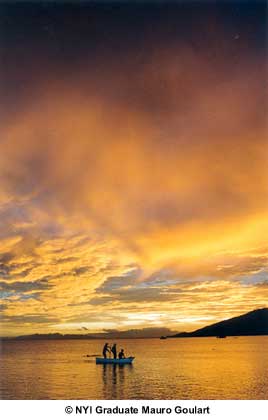
Many lovers of fine photography enjoy the work of the great Henri Cartier-Bresson (1908-2004); some think that he was the greatest photographer ever. But in addition to his splendid photographs there also exist his superb drawings, paintings, and essays. His essays contain precepts about photography, of course, but also are relevant to other art.
Cartier-Bresson believed that if you find the geometry first, the drama will take care of itself. In other words, find the locale for your photographs before you photograph the story. He believed that if you choose a place that is visually interesting and if you are patient then the picture’s real subject will ultimately appear. Ansel Adams echoed this concept in his own writings, stating that it is very important to locate your background before tripping the shutter.
Adams felt that many a good subject matter was weakened, watered down, even possibly destroyed (visually), by an insipid or almost non-existent background. Think of a play or opera on a stage devoid of scenery. Theatrical creations work if the language and dramatic action are very powerful, but scenery sets the locale and certainly helps to enhance the production.
So, take Cartier-Bresson’s advice: find the geometry first, and the drama will take care of itself.
This month’s photograph, by NYIP's Complete Course in Professional Photography graduate Mauro Goulart of Atlanta, Georgia is a good example of the importance of the background and the need to determine it before proceeding further. Suppose that he had photographed the three men in the boat and the swimmer beyond in exactly the same position but on a dull, overcast day. Could there, would there have been as much interest? There would have been some minimal interest but not much, considering the distance of the camera from the subject. Perhaps if the photographer had made the people bigger in the picture there might have been more interest.
It is the dramatic background, the brilliant sunset, that brings the picture to life. One could argue without fear of too much objection that the sunset is the subject. But if the sunset is the subject would not Mauro Goulart have cropped out the boat, the people, the water, and very possibly the distant shoreline. So I am convinced, at least, that the people are the subjects and that the sunset is merely a spectacular backdrop. And I believe that Goulart, knowingly or unknowingly, found the geometry first and let the drama take care of itself.
Let me regress for a moment and quickly identify the three NYIP Guidelines at work. The subject matter would be the people and the boats (if you look carefully, you’ll see there are also some other boats in the far distance near the land mass on the right side of the photo). The placement of the near boat emphasizes it and is a means of focusing attention on the subject. Putting the subject matter in silhouette further focuses attention. Placing the boat off center utilizes the so called Rule of Thirds. Furthermore, the reflection of the boat in the water focuses attention on the subject. The photographer simplified the photograph by confining the content to a few elements only: the people, the boats, the water, the shoreline, and the sky. Really a rather sparse picture as far as the physical elements included.
Not all landscapes contain horizons, but if a horizon is evident its placement is very important in the picture’s composition. I don’t really feel that there should be “rules” about horizons, such as the idea that the horizon should never appear in the center of a photo. This is a cliché bandied about the inner sanctums of many camera clubs and all too often the trite observations of professional writers in the camera magazines.
So, no “rules” but just a suggestion about horizons in general:
If you place the horizon very low in the photograph (as seen in this picture) the clear emphasis is going to be on the magnificent sunset. I realize that there is some conflict here because I’ve already identified the boat and people in the foreground as the subjects. Yet I can’t ignore the power of the sunset. Well, maybe you’ve seen a stage performance where the drama wasn’t as interesting as the sets.
If you place the horizon in the upper part of the photograph you obviously will be emphasizing the land, not the sky.
If you more or less evenly divide the space between land and sky you may suggest calm repose, a sense of tranquility. But you also may suggest boredom as well.
And that is enough about horizons. I’ve deliberately skipped references to celestial, heavenly, earthly possibilities, etc., leaving such observations to those interested in metaphysics.
Let’s talk about rhythm. The fine photographer and writer about photography, Barbara Morgan, once wrote that rhythm without opposition leads to boredom. By opposition she meant a break in the rhythm and then the resumption of the rhythm. There is a good deal of rhythmic movement in this photograph, but each rhythmic section shows the break in rhythm that Morgan wrote about.
The water itself has rhythm in the form of ripples, however tiny. There is rhythm in the boat, in the spacing of the people and in their reflections in the water. Speaking of reflections, it should be obvious that reflections are not the only way to show repetition, but reflections are commonly used for this purpose.
The distant shoreline shows rhythm, too — the low line of hills moving from left to right and culminating in the sharp crescendo of the dark hill on the right. The sky, of course, is full of rhythmic movements evident in the strata of dark clouds and the curving swirl moving from the lower center toward the upper left center.
Finally, consider the strong use of color in Mauro Goulart’s photograph. The orange and yellow palette is truly striking. I’m reminded of the great paintings by J.M.W.Turner, the great 19th century English landscape artist.
In closing, I'd like to reiterate what Cartier-Bresson wrote: find the geometry first, and the drama will take care of itself.






